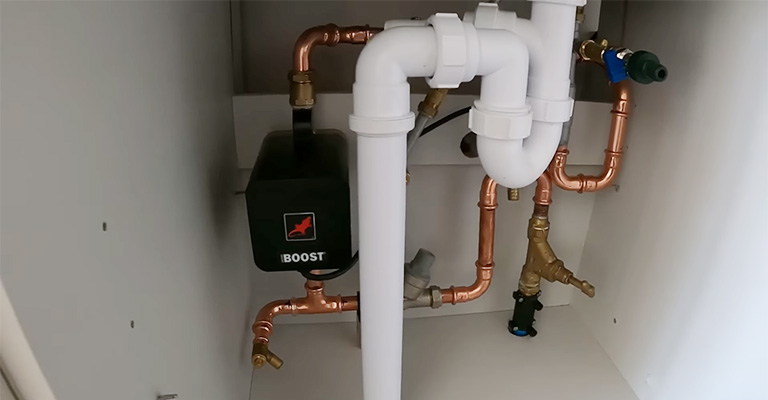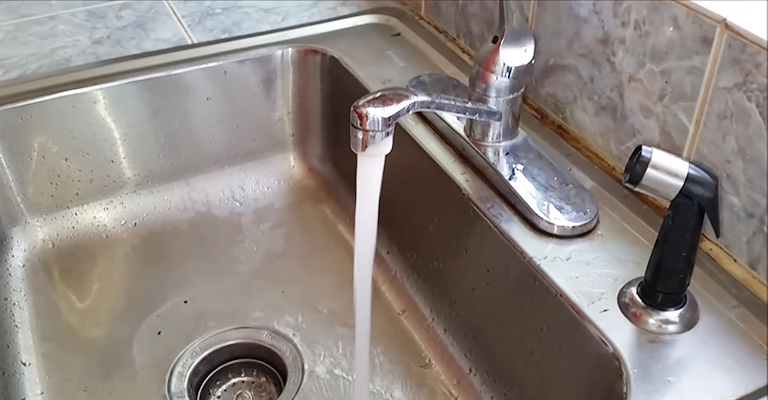There’s nothing more frustrating than turning on the kitchen faucet, expecting a strong flow of hot water, only to be greeted with a feeble trickle while the cold water flows just fine.
This common plumbing problem can leave you scratching your head.
You may have a problem with your water heater if you notice low hot water pressure at your sink, but you have fine cold water pressure.
In most cases, if your hot water heater is causing low water pressure when hot water is being used, it will affect more than one faucet at once.
When the hot water is turned on, it affects every faucet in the house. Is there a reason why water pressure is low only at the kitchen sink?
The first thing you should do if the pressure coming out of your kitchen faucet isn’t as high as it should be is to check whether it’s a whole-house problem. Is the kitchen sink the only one affected, or are all taps affected?
Maybe it’s a Quick Fix
Check under the sink before panicking about a bigger problem. Check the water line valves to see if one or both are working as they should. The pressure could have changed because one of them or both of them was turned or hit.
Next, perhaps the aerator needs to be cleaned. Aerators are the pieces found at the end of faucets.
Basically, it’s a screen that screws onto the faucet to ensure the water runs out smoothly, without sprinkling. You might be able to fix the problem by cleaning this part.
Check Other Faucets and Fixtures
The kitchen sink might be the culprit. Or, your whole plumbing system might be malfunctioning.
Make sure every faucet is working one by one as you walk around the house. It would be beneficial if you could pinpoint the problem.
Consider asking a neighbor if they are experiencing low water pressure in multiple locations, with hot and cold water, if you have low water pressure in multiple places.
It is possible that the water company is at fault. Although this isn’t good either, at least you won’t have to call the plumber unnecessarily or fix something DIY style that doesn’t need to be fixed.
A leaky faucet and lines in the kitchen should also be checked. It is certainly possible that this is the cause of pressure loss only in one spot. Also, check if it’s just the kitchen sink’s hot or cold water or the whole house.
If It’s a Problem with the Hot Water
Hot water pressure is low in your house, impacting the whole hot water supply, which indicates a water heater problem.
Make sure the shut-off valve for the hot water is working. The valve must be open. Recheck the pressure if it isn’t.
The pipes going into the water heater or the heater itself may have an issue if this does not improve the water pressure.
See if there’s a clog or obstruction in the hot water line in the kitchen sink if it’s only hot water going there.
An expert professional should be contacted whenever there is a problem with hot water, a water heater, or plumbing hardware.
Causes of Low Water Pressure in Kitchen Sink

There are several potential causes of low water pressure in a kitchen sink, so you need to determine what is causing it and resolve it. If the kitchen sink is the only one with low pressure, it may be time to examine the causes.
Clogged Aerator
Clogged aerators and cartridges are the most common causes of low water pressure in kitchen sinks.
Aerators are the parts at the end of spouts of faucets. The last thing the water touches before it exits the sink is this filter. Mineral deposits in hard water cause most aerators to clog over time.
It is relatively easy to clean them when they become clogged. You can clean the aerator by unscrewing it, removing the metal or plastic screen inside, and then brushing it.
Aerators can be cleaned thoroughly by soaking them in vinegar overnight and rinsing them the next day before they are reattached. Most clogs will be cleared by this procedure, and the water pressure should improve.
In addition, it’s a good idea to tie a gallon bag of white vinegar over the end of the faucet every few months. You should be able to avoid future clogs in the aerator and extend the life of your faucet in the long run this way.
Check Is The Cartridge
The next thing to check in the handle is the cartridge if the water pressure is still low after you have cleaned the aerator.
You don’t have a cartridge faucet if your kitchen faucet has two handles for hot water and cold water. Instead, you have a compression faucet.
When the faucet is off and the aerator is off, run the water to see if the cartridge is clogged. There may be a problem with the cartridge if the water pressure is still low.
Depending on your faucet style, you might need to remove the set screw at the bottom of the handle or pop the handle off to check.
By unscrewing the ring-shaped cartridge cover inside the handle, you’ll be able to remove the cartridge. By doing this, you will be able to inspect the cartridge itself.
In most cases, cartridges are made from brass or plastic, and are cylinder-shaped. Newer cartridges can often be cleaned if there is only minor debris inside; older cartridges with more debris should be replaced.
Make sure the rubber O-ring seals aren’t deteriorated as well. The O-rings along with a replacement cartridge can be found in a repair kit at a hardware store if these have been damaged.
Check Is The Supply Line

It is recommended that the supply line be checked next if both the aerator and the cartridge are in good shape, but the water pressure remains low.
Disconnect one of the supply lines under the sink and dump out the water inside into a bucket after shutting off the water under the sink. Then, turn the water back on while keeping the line pointed into the bucket.
Low water pressure is likely caused by a problem with the faucet itself. If the faucet is leaking water, the problem is likely inside of the faucet. The faucet doesn’t need to be fixed; it’s better to replace it with a new one instead.
Call A Plumber
It’s time to call a reputable plumber if the supply line does not produce any water. He or she can diagnose the problem accurately and solve the issue using their tools and expertise.
You’ll also want to keep in mind that low pressure is less likely to be caused by a clogged aerator than by sediment in the home’s water heater if it only occurs while hot water is running.
Water heaters can be flushed by a licensed plumber if the problem persists. It is generally a good idea to flush your water heater every six months (or more often if your home has very hard water).
This will increase the lifespan of your water heater, reduce your electricity or gas bills, and keep your hot showers nice and hot.
Clogged aerators can cause low water pressure, so check your kitchen sink aerator if you experience low water pressure in your sink or other faucets in the house.
Consider Recent Works
When you have experienced a recent drop in pressure, check whether you have recently added any extra water outlets into your home; if there is more demand, you may have experienced a decrease in pressure. There is a possibility that the main water pipe would need to be expanded if this is the case.
Primary Cause Of Hot Water Pressure Is Low but Cold Is Fine

It is almost certain that the problem is with the hot water heater if the hot water pressure is only low with the hot water. Make sure the hot water shutoff valve is working.
Make sure it’s open. In case it isn’t, try opening it and checking the pressure again. It is most likely that you have a problem with the pipes going into the hot water heater or with the unit itself if this doesn’t improve the water pressure.
For your own safety, we recommend only a professional plumber perform work on a hot water heater.
When water heaters aren’t flushed regularly, they build up sediment over time, just like faucet aerators. Whenever possible, flush your tank and tankless water heater annually.
If your water is extremely hard, you may want to flush them more frequently. Sediments in the water such as calcium build up over time, and if not flushed out, they can reduce the water heater’s capacity to heat water, increase its energy usage, and decrease water pressure.
Your water heater may need to be flushed if it’s not heating water as fast as it used to and there is low pressure when it comes to hot water.
Licensed plumbers can flush your water heater if sediment buildup is causing low hot water pressure in your sinks.
When you haven’t flushed it for five years or more, flushing may not work. Depending on how much sediment and debris has built up inside the water heater, flushing may not be effective.
You may need to replace your water heater if you hear popping sounds from it, a sign of too much sediment buildup inside that is too late to flush.
To avoid plumbing problems that would otherwise arise, it’s prudent to schedule routine maintenance on your water heater with a plumbing professional.
A regular water heater maintenance program will extend the life of your water heater, reduce energy consumption and your electricity or gas bills, and ensure you have plenty of hot water to use.
Check The Pressure
The pressure-reducing valve may also be to blame for low hot water pressure. The bell-shaped device will be situated on the water line and will control hot water pressure from the municipal water.
You can increase hot water pressure by loosening the top screw of the valve – turn it counterclockwise. Check whether anything has changed by running the hot water again after you have tried this.
There are times when a valve needs to be replaced because of wear or damage caused by sediment.
Shutoff Valve
There may be a simple answer to your question: the shutoff valve may be closed.
A non-complete turn off can decrease water pressure if they control the amount of water flowing through the faucet.
Recheck your pressure by running hot and cold water to compare your pressure after turning the handles of the shut-off valve all the way to the right.
Final Words
Low water pressure can be caused by a number of things, such as a leak, a valve, a build-up of unwanted substances, or a hot water heater.
If your cold water is also affected, then you can narrow down the problem source by considering if it is affected the same way.
To restore everything to normal, we have outlined the most common causes and some easy solutions to get things going again.
There are times, however, when calling the professionals is the best course of action; pressure is a tricky subject, and it can be easy to go wrong.








